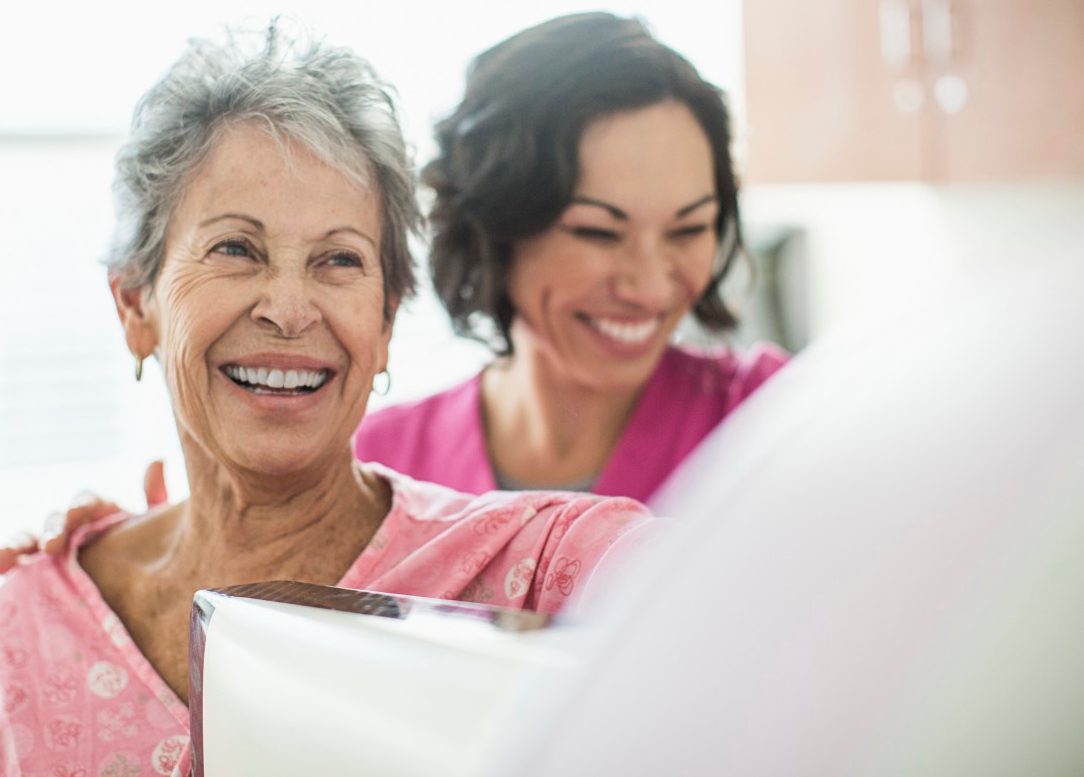What You Should Know About Three-Dimensional Mammograms

A three-dimensional imaging mammogram has pluses, but it won't eliminate unnecessary care. Here's what you need to know about digital tomosynthesis.
In a standard mammogram, a technician takes two x-rays of each breast from different angles: top to bottom and side to side.
You know the drill. Your breast is compressed between two glass plates. Later a radiologist reads the pictures, examining any irregular whiter areas — sometimes called shadows — that may indicate cancer cells, which are denser than healthy breast tissue.
YOU MIGHT ALSO LIKE: The Many Types of Breast Cancer
In a three-dimensional (3-D) mammogram, called digital tomosynthesis, you’ll still need to put your breast on a plate, but it won’t be squeezed so much.
In about seven seconds, the device takes 11 images from various angles. That data is then assembled into a clear 3-D image.
According to the nonprofit breastcancer.org, ordinary mammograms are “like standing on the edge of a forest, looking for a bird somewhere inside. To find the bird, it would be better to take 10 steps at a time through the forest and look all around you with each move” — something like a 3-D breast screen.
If you’re particularly at risk of breast cancer, have dense breasts, or have skipped mammograms because you hate the process, you might seek out a 3-D exam.
Many women have been getting yearly mammograms since their 40s, along with performing self-breast exams. The U.S. Preventive Services Task Force (USPSTF) recommends waiting until your 50s and testing every two years. The group is updating its report, however, and has received evidence that starting mammograms every two years beginning at 40 or 45 could save lives.
Talk to a gynecologist about the appropriate timing for you, especially if you have a family history of breast cancer.
You’ll be weighing the pluses and minuses. Breast x-rays miss cancers about 20 percent of the time. They also produce false positives. If your x-ray leads to questions — perhaps simply because your breasts are dense — you’re typically referred for a follow-up, often an ultrasound, which catches more cancers but also produces false positives.
Middle-aged women generally know more than one woman who has gone through a draining false breast-cancer scare.
In the United States, around 43 percent of women 40 and older have dense breasts and double the risk of developing breast cancer. They’re often steered to get an ultrasound from the start, alongside an ordinary mammogram. Some evidence suggests that ultrasound detects more cancers. (The USPSTF hasn’t signed on, however.)
A growing number of women are opting for a 3-D mammogram, which may catch as many as 50 percent more cancers, according to a study of more than 1.5 million exams. The 3-D exam also has fewer false-positives, other research concluded.
Insurers may not cover a 3-D exam, and some screening centers charge women an extra $50. You may need to travel to find one. The technology also involves more exposure to radiation, although the risk may be minor.
(If you have been tempted to try thermograms or nipple aspirates, which providers have described as alternatives or complements to mammograms, note that the Food and Drug Administration has found no evidence to support those claims).
The big risk of all breast cancer screening is unnecessary anxiety. If 1,000 women with dense breasts get an ultrasound after a negative mammogram, the test will catch two to three cancers. But it will show up to 117 potential problems that will turn out to be false positives.
You also run the risk of unnecessary treatment. Even biopsy results can be unclear and require a second opinion. Well-meaning specialists and doctors may go on to detect true cancer cells — but small ones that would never develop into a real problem.
An analysis of three decades of testing concluded that 1.3 million American women had been diagnosed with cancer when they actually didn’t require treatment. In one year alone, the authors concluded that 31 percent of all breast cancers diagnoses were a mistake.
A Cochrane meta-analysis painted a bleak picture. Overall, “for every 2,000 women invited for screening throughout 10 years, one will have her life prolonged and 10 healthy women, who would not have been diagnosed if there had not been screening, will be treated unnecessarily. Furthermore, more than 200 women will experience important psychological distress for many months because of false-positive findings. It is thus not clear whether screening does more good than harm,” the authors wrote.
It’s not cynical to describe diagnosing and treating breast cancer as a business. People make money in medical care of all kinds. Screening leads to more customers. Once a threat has been detected, however slim, it’s very hard to pass up treatment.
On the flipside, you could be one of the women who gets care in time to beat a deadly cancer. A study of about 50,500 women concluded that keeping to a schedule of exams lowered their chance of dying of breast cancer by 50 percent, compared to women who never had their breasts examined. Missing exams cut into that benefit.
Speak candidly to your gynecologist about your concerns and decide at what age and how often you’d like to get screened.
YOU MIGHT ALSO LIKE: Late-Stage Breast Cancer Is Rising Among Younger Women
Updated:
December 18, 2023
Reviewed By:
Janet O’Dell, RN